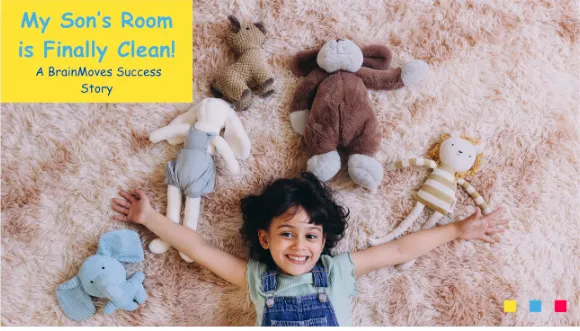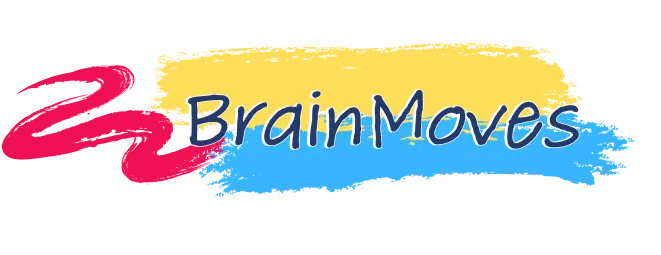
My Son's Room is Finally Clean! A BrainMove Success Story
When Billy's mom called to schedule a BrainMoves session for her six year old son she told me that nothing she did was helping her son keep his room clean. She said she couldn't walk normally when she went into his room because there was so much stuff on the floor that she had to step over the piles. Clothes, shoes, toys and blankets were spilling out of his closet.
Sometimes it got so bad that his things were spilling out into the hallway outside his bedroom door. She had bought him shelves, toy boxes, containers, closet organizers and shoe organizers and he just piled things on top of them in a disorganized mess. No amount of nagging, consequences, helping him clean his room, talking to him about how important it was to have an organized room helped. When she helped him clean his room it started getting cluttered again immediately.
Billy's mom had heard that doing the BrainMoves movements could help with Billy's organizational skills. I told her that the movements helped children and adults create new neural pathways in their brains that help them stay neat and organized.
Billy was a polite, friendly boy. He liked to draw pictures so I asked him if he would like to draw with me. We each drew a picture and admired each other's work. I asked Billy if he could draw me a picture of his room. The picture that he drew was full of scribbles and dark colors. It was disorganized and looked like something a much younger child would draw. There was a stick drawing of him in the bottom right hand corner of the paper. It was small and black.
Billy's artwork representing his room before doing BrainMoves with "goals."
From looking at his picture I thought that Billy had probably missed doing some important early developmental reflexes that are designed by nature to help with organizational skills. From what his mother had described, it was too big a job for him, since he didn’t have the proper brain structure to be and stay organized.. When I asked Billy about his drawing, he said that he felt better when his room was messy. I asked him if it was hard to concentrate and do his homework in his room and he said yes.
I didn't need any more information and suggested that we write a "postive belief" and do some BrainMoves movements. The nice thing about doing BrainMoves is that I don't need to do psychotherapy or talk with a child about his problem very much in order to get the work done. Children usually don't like talking about their problems, especially with an unfamiliar adult. I suggested a positive belief of "I am able to clean my room," and Billy liked the statement.
We did some BrainMoves movements for about 10 minutes and I suggested another positive belief of "I like how I feel when my room is clean," and Billy agreed to do that belief, too. After a few more movements I added a statement of "I am willing to keep my room clean" and we did more movements. Then I asked Billy to draw a picture of his room again. This time he drew himself as a much larger figure in a light green color in the middle of the room and drew circles around himself using brighter colors. Then he added a rectangle and wrote "bed" in the middle of it, a circle and wrote "table" in the middle of it and a group of vertical lines and wrote "shelf" under it. I asked Billy how he felt when he looked at his picture and he said, "Good."
Billy's artwork representing his room after doing a BrainMoves session with "positive beliefs."
I asked Billy's mother to call me in a few weeks and let me know how he was doing. I told her that Billy had done a lot of work and that he might need some time to integrate his session, so it would be best not to push him. When Billy's mother called me two weeks later, she was laughing. She told me that Billy had come home from his BrainMoves session and went into his room and hung up his jacket in the closet. He picked up a couple of shirts from the floor and put them in the laundry basket. Billy's mother reinforced his new behavior with some positive noticing and he gave her a big smile. He then pushed some things off of his bed onto the floor and picked up a book and started to read.
This pattern continued over the next two weeks. Rather than making a big project out of cleaning his room, each day Billy put the things away that he had been wearing or using where they belonged and then spent a few minutes dealing with a some of the things lying around on his floor or bed or in his closet - dirty clothes into the laundry basket, books on a shelf, toys into a container, trash in the garbage can. Billy's mom kept reinforcing his behavior with positive noticing. She helped a little by emptying out the trash can and laundry basket so he wouldn't get overwhelmed by those things getting too full.
About ten days after his BrainMoves session Billy asked his mother to help him rearrange his shelves for his books. She was happy to help and they had a fun half an hour working on this project together.
Billy's mother told me his room wasn't clean yet, but that it was about 60% better. I told her that his new behavior should continue and that it might be all right now to make suggestions that might help as she thought of them. She said that maybe Billy would use a white board and a bulletin board now. I told her she could always schedule more BrainMoves sessions or take a class if she thought Billy needed more help. She said she would and called me about a month later to tell me that Billy's room was clean and was staying clean. His grades had improved, too and he had noticed how much easier it was to concentrate and do his homework. She signed up for my BrainMoves class so she could keep doing movements with Billy.
Billy's mother and I had expected that after his BrainMoves sessions Billy would be more willing to just spend a few days cleaning his room and keep it clean after that. What Billy did was much more organic and effortless. This is one of the things I like about BrainMoves. The movements create healthy brain structures which allow our inner wisdom to come through and become creative in ways we might not otherwise consciously plan for ourselves.
Please note: All of the stories in this category are true. The names and other identifiers have been changed to protect confidentiality.

